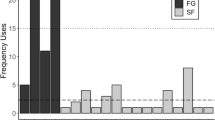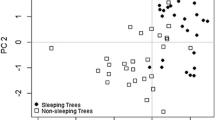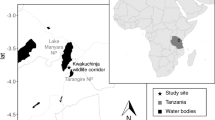Abstract
Predation pressure affects most aspects of primate behaviour, and is especially pronounced in the context of the use of sleeping sites, given the vulnerability of the animal at this time. Most small-bodied platyrrhines have highly systematic patterns of sleeping site choice and use. This study analyses the use of sleeping sites by a free-ranging group of titis (Callicebus coimbrai) monitored at a site in Sergipe, Brazil, between July, 2009 and June, 2010. When the subjects approached a sleeping tree their behaviour was typically cautious, including slow and silent movement, early retirement (20–162 min before sunset on 52 dry afternoons), and sleeping in a tight huddle with their tails entwined. Despite this behaviour, which has an obvious anti-predator function, the group slept in only three different trees during the course of the study, and returned to the same tree used on the previous night on a quarter of evenings (n = 56). This was despite the availability within the group’s home range of a large number of trees with similar structural characteristics (i.e. tall, open crown in the upper canopy). Surprisingly, the three trees were all members of the same species, Licania littoralis (Chrysobalanaceae). The choice of this species, which was not an important source of dietary resources, and the repeated use of a small number of sites, did not seem to be related to factors such as ranging or foraging patterns, but may have a been a response to the specific threat from capuchins, Cebus xanthosternos.




Similar content being viewed by others
References
Altmann J (1974) Observational study of behaviour: sampling methods. Behaviour 49:227–267
Anderson JR (1984) Ethology and ecology of sleep in monkeys and apes. In: Rosenblatt JS, Beer C, Busnel MC (eds) Advances in the study of behavior. Elsevier, Philadelphia, pp 165–229
Anderson JR (1998) Sleep, sleeping sites, and sleep-related activities: awakening to their significance. Am J Primatol 46:63–75
Caine NG, Potter MP, Mayer KE (1992) Sleeping site selection by captive tamarins (Saguinus labiatus). Ethology 90:63–71
Chagas RRD, Ferrari SF (2010) Habitat use by Callicebus coimbrai (Primates: Pitheciidae) and sympatric species in the fragmented landscape of the Atlantic Forest of southern Sergipe, Brazil. Zoologia 27:853–860
Chapman CA, Chapman LK, McLaughlin RL (1989) Multiple central place foraging by spider monkeys: travel consequences of using many sleeping sites. Oecologia 79:506–511
Cisneros-Heredia DF, Leon-Reyes A, Seger S (2005) Boa constrictor predation on a titi monkey, Callicebus discolor. Neotrop Primates 13:11–12
Cowlishaw G (1994) Vulnerability to predation in baboon populations. Behaviour 131:293–304
de Luna AG, Sanmiguel R, Di Fiore A, Fernandez-Duque E (2010) Predation and predation attempts on red titi monkeys (Callicebus discolor) and equatorial sakis (Pithecia aequatorialis) in Amazonian Ecuador. Folia Primatol 81:86–95
Di Bitetti MS, Vidal EML, Baldovino MC, Benesovsky V (2000) Sleeping site preferences in tufted capuchin monkeys (Cebus apella nigritus). Am J Primatol 50:257–274
Duarte MHL, Young RJ (2010) Sleeping site selection by urban marmosets (Callithrix penicillata) under conditions of exceptionally high predator density. Int J Primatol. doi:10.1007/s10764-010-9468-5
Ferrari SF (2009) Predation risk and antipredator strategies. In: Garber P, Estrada A, Bicca-Marques JC, Heymann E, Strier KB (eds) South American Primates—comparative perspectives in the study of behavior, ecology and conservation. Springer, New York, pp 251–277
Ferrari SF, Lopes MA (1990) Predator avoidance behaviour in the buffy-headed marmoset, Callithrix flaviceps. Primates 31:323–338
Fruth B, McGrew WC (1998) Resting and nesting in primates: behavioral ecology of inactivity. Am J Primatol 46:3–5
Hamilton WJI (1982) Baboon sleeping site preferences and relationships to primate grouping patterns. Am J Primatol 3:41–53
Heiduck S (2002) The use of disturbed and undisturbed forest by masked titi monkey Callicebus personatus melanochir is proportional to food availability. Orix 36:133–139
Heymann EW (1995) Sleeping habits of tamarins, Saguinus mystax and Saguinus fuscicollis (Mammalia; Primates; Callitrichidae), in north-eastern Peru. J Zool 237:211–226
Kappeler PM (1998) Nests, tree holes, and the evolution of primate life histories. Am J Primatol 46:7–33
Kinzey W (1978) Feeding behaviour and molar features in two species of titi monkey. In: Chivers DJ, Herbert J (eds) Recent advances in primatology. Academic Press, London, pp 373–385
Kinzey WG, Becker M (1983) Activity pattern of the masked titi monkey, Callicebus personatus. Primates 24(3):337–343
Kinzey WG, Rosenberger AL, Heisler PS, Prowse DL, Trilling JS (1977) A preliminary field investigation of the yellow handed titi monkey, Callicebus torquatus torquatus, in northern Peru. Primates 18:159–181
Lawrence JM (2003) Preliminary report on the natural history of brown titi monkeys (Callicebus brunneus) at the Los Amigos Research Station, Madre de Díos, Peru. Am J Physiol Anthropol. (Suppl 36):136
Liu H-Z, Zhao Q-K (2004) Sleeping site of Rhinopithecus bieti at Mt. Fuhe, Yunnan. Primates 45:241–248
Miller LE, Treves A (2007) Predation on primates. In: Campbell CJ, Fuentes A, MacKinnon KC, Panger M, Bearder SK (eds) Primates in perspective. Oxford University Press, New York, pp 525–543
Neri FM (1997) Manejo de Callicebus personatus, Geoffroy 1812, resgatados: Uma tentativa de reintrodução e estudos ecológicos de um grupo silvestre na Reserva do Patrimônio Natural Galheiro—Minas Gerais. Dissertation, Belo Horizonte: Universidade Federal de Minas Gerais
Palacios E, Rodriguez A, Defler TR (1997) Diet of group of Callicebus torquatus lugens (Humboldt, 1812) during the annual resource bottleneck in Amazonian Colombia. Int J Primatol 18:503–522
Raemaekers JJ, Chivers DJ (1980) Socio-ecology of Malayan forest primates. In: Chivers DJ (ed) Malayan forest primates: ten years’ study in tropical rain forest. Plenum Press, New York, pp 279–316
Sampaio DT, Ferrari SF (2005) Predation of an infant titi monkey (Callicebus moloch) by a tufted capuchin (Cebus apella). Folia Primatol 76:113–115
Scarano FR (2002) Structure, function and floristic relationships of plant communities in stressful habitats marginal to the Brazilian Atlantic Rainforest. Ann Bot-London 90:517–524
Smith AC, Knogge C, Huck M, Löttker P, Buchanan-Smith HM, Heymann EW (2007) Long-term patterns of sleeping sites in wild saddleback (Saguinus fuscicollis) and mustached tamarins (S. mystax): effects of foraging, thermoregulation, predation, and resource defense constraints. Am J Phys Anthropol 134:340–353
Souza-Alves JP (2010) Ecologia alimentar de um grupo de Guigó-de-Coimbra-Filho (Callicebus coimbrai Kobayashi & Langguth, 1999): perspectivas para a conservação da espécie na paisagem fragmentada do sul de Sergipe. Dissertation, São Cristóvão: Universidade Federal de Sergipe. p 108
Souza-Alves JP, Ferrari SF (2010) Responses of wild titi monkeys, Callicebus coimbrai (Primates: Platyrrhini: Pitheciidae) to the habituation process. Zoologia 27:861–866
Tabacow FP, Mendes SL, Strier KB (2009) Spread of a terrestrial tradition in an arboreal primates. Am Anthropol 111:238–249
Time and Date (2010) [15:32:40] http://www.timeanddate.com/worldclock/sunrise.html
Wang S, Luo Y, Cui G (2011) Sleeping site selection of François’s langur (Trachypitecus francoisi) in two habitats Mayangue National Nature Reserve, Guizhou, China. Primates 52:51–60
Zhang S-Y (1995) Sleeping habits of brown capuchin monkeys (Cebus apella) in French Guiana. Am J Primatol 36:327–335
Zhao QK (1999) Responses to seasonal changes in nutrient quality and patchiness of food in a multigroup community of Tibetan macaques at Mt. Emei. Int J Primatol 20:511–524
Acknowledgments
This study was supported by the Deutscher Akademischer Austausch Dienst (DAAD), CNPq (processes no. 302747/2008-7 and 476064/2008-2), and the Fundação O Boticário de Proteção à Natureza (project # 0846_20092), and received logistic support from the Sergipe state environment secretariat (SEMARH) and the Brazilian National Primate Center (CPB-ICMBio). We would also like to thank Sr. Ary Ferreira, owner of Fazenda Trapsa, for supporting our research and José Elias “Bóia” and Renata Chagas for their assistance during fieldwork. We are also grateful to two anonymous reviewers for their helpful comments on the first version of this manuscript.
Author information
Authors and Affiliations
Corresponding author
About this article
Cite this article
Souza-Alves, J.P., Fontes, I.P. & Ferrari, S.F. Use of sleeping sites by a titi group (Callicebus coimbrai) in the Brazilian Atlantic Forest. Primates 52, 155–161 (2011). https://doi.org/10.1007/s10329-011-0235-9
Received:
Accepted:
Published:
Issue Date:
DOI: https://doi.org/10.1007/s10329-011-0235-9




